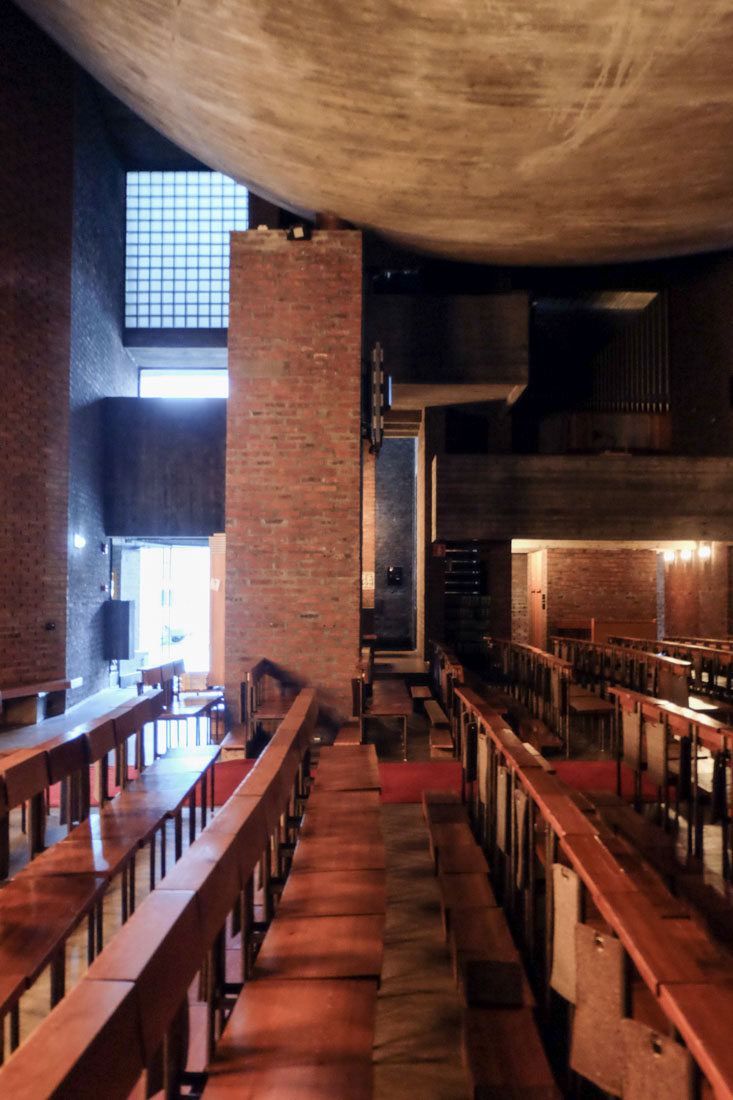 |
 |
 |
 |

St. Hallvard Church and Monastery
Enerhauggata 4, Oslo
1959 - 1966
The
St.Hallvard church with monastery was built between 1959 and
1966 according to a design by the architects Lund
& Slaatto. The compact building is located in
Enerhaugen, a workers' quarter east of the city center of
Oslo. The building offers space for around 300 to 350 people
and an additional 70 seats in the chapel. At the center of
the city district is located the monastery with church and
parish center on a rocky hill, surrounded by high-rise
residential buildings. The architects react to this unusual
situation with an introverted building. The cube made of red
brick masonry has a closed appearance and only opens to the
south through the windows of the monastery. The three areas
of the building complex are separated from one another by
slot-like incisions in the exterior. The northern incision
accommodates the recessed entrance to the church. The
circular shape of the completely envolved church is
inscribed in the compact cube. A concave dome hovers over
the nave. This majestic, inverted dome appears to be shaped
from above. It gives the visitor a feeling of the power of
the sky, as if it had created the majestic shape. Despite
its dominant effect, the dome also creates an intimate
sacred space. As opposite the dome, the floor of the nave
rises slightly towards the altar, emphasizing a feeling for
the earth. For acoustic reasons, the walls are inclined
outwards by 3 °. The interior is bathed in a mystical
twilight. Apart from the large glass block wall above the
entrance door, there is hardly any natural light in the
room.
Die
Kirche St.Hallvard mit Kloster entstand in den Jahren 1959
bis 1966 nach einem Entwurf der Architekten Lund
& Slaatto. Das kompakte Gebäude befindet sich in
Enerhaugen, einem Arbeiterquartier östlich des Stadtzentrums
von Oslo. Das Gebäude bietet Platz für rund 300 bis 350
Personen und zusätzliche 70 Sitzplätze in der Kapelle. Im
Mittelpunkt des Stadtviertels liegt das Kloster mit Kirche
und Pfarrzentrum auf einem felsigen Hügel, umgeben von
Wohnhochhäusern. Auf diese ungewöhnliche Situation reagieren
die Architekten mit einem introvertierten Gebäude. Der Kubus
aus rotem Backsteinmauerwerk zeigt ein geschlossenes
Erscheinungsbild, und öffnet sich lediglich nach Süden durch
die Fenster des Klosters. Die drei Bereiche der Gesamtanlage
werden durch schlitzartige Einschnitte im Aussenbau
voneinander getrennt. Der nördliche Einschnitt nimmt den
zurückversetzten Eingang zur Kirche auf. In den kompakten
Kubus ist die Kreisform der vollständig umbauten Kirche
eingeschrieben. Über dem Kirchenschiff schwebt eine konkave
Kuppel. Diese majestätische, umgekehrte Kuppel scheint von
oben geformt zu sein. Sie vermittelt dem Besucher ein Gefühl
der Kraft des Himmels, als ob dieser die majestätische Form
geschaffen hätte. Trotz ihrer dominanten Wirkung erzeugt die
Kuppel aber auch einen intimen Sakralraum. Als Gegenüber der
Kuppel steigt der Boden des Kirchenschiffs zum Altar hin
leicht an, und betont damit eine Empfindung für die Erde.
Aus akustischen Gründen sind die Wände um 3° nach aussen
geneigt. Der Innenraum ist in ein mysthisches Dämmerlicht
getaucht. Abgesehen von der grossen Glasbausteinwand über
der Eingangstür fällt kaum natürliches Licht in den Raum.
